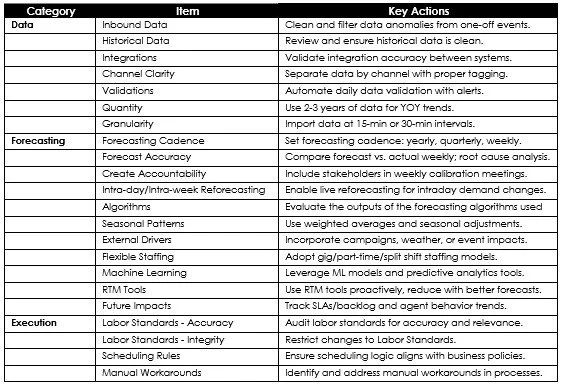WFM Forecasting Best Practices: A Short Guide to Ensure Accurate Forecasts
1. Data Hygiene
a. Data Quality
· Inbound Data: Create processes to clean data which include removing/adjusting outliers caused by one-off events (e.g., system outages, promotions, cancellations, weather).
· Historical Data: Review all historical data. If there were issues with data quality at any given time period in the past, it may be impacting forecasts. Ensure data hygiene at every level.
· Integrations: Review what data the system is actually using and set up processes to validate that the integrations are bringing in accurate inbound data. The data seen by the forecasting engine may be different than the data shown on the BI tool. If you have outbound data going to other systems – as a system owner, ensure your outbound data is reaching other systems correctly.
· Channel Clarity: In retail, each type of retail channel – full price, outlet, online need their own Labor Standards. In Contact Centers, this translates to how the interaction happens - phone, chat, and email have different volumes and patterns – ensure inbound data for channels are ingested separately and attached to the right Labor standards.
· Validations: Run DAILY automated validations of inbound and system data. Create alerts based on set thresholds. Daily data may change at the end of the week – include in validation process if this occurs.
b. Data Quantity and Granularity
· Quantity: Use recommended amount of data time frame – may need to go beyond 12 months. Use as much as the system will allow – 2-3 years for better Year over Year trends.
· Granularity: Bring in data in 15-min (or 30-min) intervals allowing granular accuracy in forecasts. This can significantly improve forecast quality and resulting schedules.
2. Forecasting Processes
a. Forecasting Processes and Algorithms
· Forecasting Cadence: Yearly – create “Bottoms-up” labor cost forecasts to align with Finance’s “Top-down” budgeting. Adjust quarterly with reforecasts based on updated trends and profitability goals. Forecast weekly at 2-4 weeks-in-advance cadence aligning with company scheduling policies and state or local labor laws.
· Forecast Accuracy: Compare forecast vs. actual EVERY WEEK. Set forecast accuracy percentage targets. Identify root causes of variances and fine-tune models accordingly. Be granular in this review. Create reporting tools that monitor forecast accuracy by metric and in a granularity that delivers a clear understanding of how to improve results.
· Create Accountability and Transparency: Involve stakeholders in forecast reviews - business leaders, finance partners, and other stakeholders should participate in weekly calibration sessions. This creates self-accountability and transparency. It is collaborative and builds trust.
· Intra-day/Intra-week Reforecasting: Recalculate forecasts throughout the day/week based on live data (e.g., queue spikes, absenteeism). Create the ability to adjust forecasted models and maintain profitability during peak volume.
· Algorithms – Comprehensive Review of Forecast Outputs: Better WFM tools come with built-in forecasting algorithms that can refine their own results. However, It is crucial that the forecasting team understands what these algorithms do and what results they produce. The right algorithm for the right channel and data set can make a night and day difference. Have a business process in place to review the outputs of these forecasting algorithms.
b. Considerations
· Rolling averages and seasonal patterns: Apply moving averages, weighted historical data, and seasonality decomposition when and as needed.
· Incorporate external drivers: ADD marketing campaigns, weather, or product launches and market specific events.
· Incorporate flexible staffing models: Gig, part-time, or split shifts to better respond to forecast accuracy limits.
· Machine learning models: Use both internal and external AI tools to detect patterns and adjust forecasts when and if needed. Use predictive analytics from other systems to benchmark.
· RTM for Contact Centers: using integrated Real Time Management (RTM) tools enable proactive changes to schedules. This can provide insights to forecast variances as they happen.
· FUTURE Impacts to Forecasts: Monitor SLAs and backlog trends. Factor in how service goals and backlogs might shift future volume and handle time. Account for agent behavior patterns that impact customers e.g., high absenteeism on weekends, or shift preference trends. These are scheduling trends but they can cause variances to forecasted labor.
3. Execution
The following areas should also be reviewed. The problem may not be in the data or in the forecast or the labor standards. It could be in one of the other areas.
· Labor Standards – Accuracy: Accurate Labor Standards: Sometimes forecasts are excellent, but labor standards are incorrect. This results in incorrect labor and poor scheduling. Review the accuracy of labor standards. If dated – you may need a project to adjust/ revise the standards. Labor standards can change over time due to improved average agent skills, new technology, business process changes, changes in channel types, etc.
· Labor Standards – Integrity: Teams sometime change labor standards to adjust to budgets or come within an expected metric. This can have a serious and unexpected impact on the quality of the labor demand generated. Restrict any change to labor standards.
· Schedules: Review scheduling rules and configurations. Is the system actually creating schedules as expected? No matter how good the forecasts are, issues with the scheduling engine will variances.
· Manual Workarounds: Sometimes workarounds are created out of good intentions to deliver better results. Although they may have worked once, they can now be causing unintended issues. It is important to understand if at any phase of the Data Ingestion, Forecasting, Labor Generation or Scheduling process, a workaround was created and what impact is that “workaround” actually having on the results.
